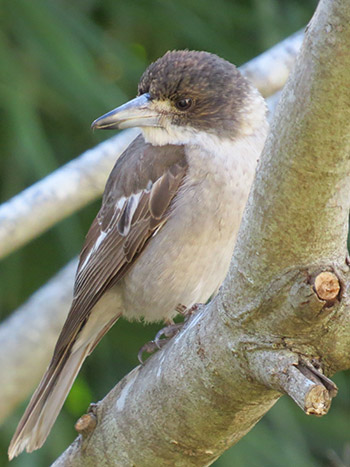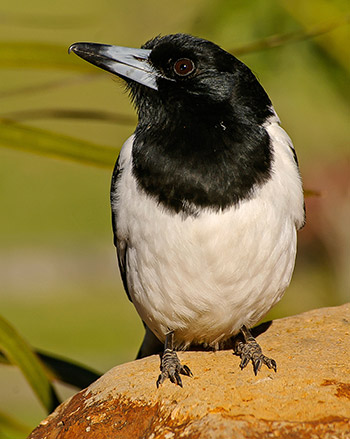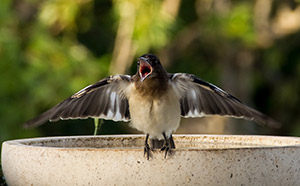Birds
Butcher bird Removal – advice & relocation
Butcher bird
Grey Butcher bird
(Cracticus torquatus)
Other common names: Silver-backed Butcher bird, Derwent Jackass, Whistling Jack, Collared Crow-shrike, Grey Shrike.
Pied Butcher bird
(Cracticus nigrogularis)
Other common names: Black-throated Butcher bird, Black-throated Crow-shrike, Break-o’day Boy.
Physical description:
Grey Butcher bird

Grey Butcher bird
- Medium-sized black, white and grey bird attaining a size of 24-30cm in length.
- Head and face black with white collar, grey back, grey-white wings, white underparts white tipped black tail. Clearly visible white patch behind the ear. Bill is grey and black with a hook on the end of the upper bill.
- Eye is dark brown and the legs and feet are dark grey
- Sexes are similar with females slightly smaller. Juvenile’s black regions are olive-brown in appearance and the white washed out. The bill is completely dark grey.
- Small head & long neck are bare-skinned & reddish in colouring.
- exes are easily distinguished: males have a redder head & neck and a distinguishing yellow wattle especially during breeding season; females are more drab and have no wattle.
Pied Butcher bird

Pied Butcher bird
- Large black and white bird reaching an average body size of 32cm.
- Head, neck, throat and breast black with a white collar separating the black back. Black wings with a bold white bar, white rump and black tail with white tips on the outer feathers.
- Beak long and straight, grey with a black tip and slightly hooked.
- Eye a dark brown with the legs and feet black.
- Sexes similar with female slightly smaller. Juvenile’s duller brown in black regions and white regions are buff white.
Ecology:
Grey Butcher bird
- Occupy a number of different habitat types from rainforest, margins of forests and woodlands, open woodlands, coastal and inland scrub, riverine woodland, farmland and suburban areas with trees.
- An aggressive feeder, it preys upon small animals, including birds, lizards and insects
Pied Butcher bird
- Inhabit drier woodlands and forests, scrublands, pastoral lands with trees and suburban areas.
- An aggressive feeder, it preys upon small animals, including birds, lizards and insects.
Breeding
Grey Butcher bird
- Breeding season occurs from July or August through to December.
- Nest consists of an untidy bowl of dry sticks lined with soft dry vegetation such as grass and bark. Nest is placed in the upright fork of a fork in a small tree or sapling, with trees in denser scrub preferred.
- Clutch consists of 3 to 5 eggs, pale brownish-green to pale brown often with a reddish tinge, approximately 31mm x 23mm and oval shaped.
- Females incubate the eggs for 25 days, with the young birds leaving after just 28 days.
- Juveniles remain in their parent’s territory for about a year and help raise the chicks next season.
Pied Butcher bird

Juvenile Butcher bird
- Breeding seasons for Pied Butcher birds varies throughout its distribution, with birds in the north breeding from May to November, and in the south breeding from August to November.
- Nest consists of an untidy bowl of dry sticks lined with soft dry vegetation such as grass and bark. Nest is placed in the upright fork of a fork in a small tree or sapling, clear of foliage and more than 5 meters above ground level. Prefers open areas for nesting.
- Clutch usually contains 3 or 4 eggs, sometimes only 2, which can be greyish-green to light olive to pale brownish-green. Slight lustre and spotted and blotched towards the larger end varying from blackish-brown to reddish-brown. Approximately 38mm x 27mm in size and oval in shape.
- Female incubates the eggs for 21 days, and young birds leave the nest after 29-32 days.
- More than one female may lay her eggs in the same nest.
Suburban Butcher birds:
- Butcher birds are protected under state legislation and it is an offence to harm or interfere with their nests and chicks.
- Habitat modification in suburban areas has assisted the life history requirements of Butcher bird species. Areas previously suited to only a few birds are now able to support considerably higher densities.
- Feeding the birds may encourage individuals or family groups to stay in an area permanently as you provide a readily available food resource.
- Butcher birds are territorial animals and will attempt to drive away anything which they feel is a threat to their nest and or chicks.
Living with Suburban Butcher birds
So what can you do to try and deter an swooping Butcher bird in your yard before butcher bird removal?
- Don’t feed the birds, as this should encourage them to stay within your area.
- Don’t destroy the nest or interfere with the chicks. They only swoop while there are eggs or chicks in the nest. If you have a nest in your vicinity temporarily avoid the area.
- Clean up pet food and rubbish to avoid birds scavenging scraps.
- Informing neighbours and council of resident swooping birds and erecting warning notices may assist in awareness and areas to be avoided during breeding months.
- Maintain eye contact with the offending bird. In only the rarest cases will birds make contact with you if you are watching them.
- Carrying a hat, umbrella or alternate object which you can hold above you head can help in deterring birds from swooping. Walking in a group is also a great tactic, as birds often will only target individuals.
- Placing eye spots on your bike helmet, wearing sunglasses on the back of your head or keeping the bird in eye contact also helps prevent swooping.
Butcher bird removal and relocation
If your best efforts of deterring the bird fail then butcher bird may be your last resort. Ecologically-minded butcher bird removal requirements, and ecologically sound translocation methods are employed by licensed professionals for effective Butcher bird removal.
Butcher bird removal done in accordance with requirements stipulated by the Department of Environment and Science and permits are issued after stringent examination as to knowledge and suitability to actively manage conflict birds and conduct activities such as buther bird removal..
Every effort is made to ensure the birds are managed as to welfare, and to minimise any possible harm whilst being trapped, upon trapping, and through transit to a suitable release site after butcher bird removal. Sites for release are selected upon prior inspection as to their suitability for Butcher bird habitat.
Magpie removal contacts for Brisbane, Gold coast and surrounding areas can be reached for the following areas:
Brisbane West including The Gap, Bardon, Chapel Hill, Kenmore, Brookfield, Sinnamon Park Oxley, Algester, Forestdale and surrounding suburbs
0413 028 081
Ipswich and surrounding suburbs
0413 028 081
Brisbane North, including Moreton Bay Regional council areas south of Caboolture
0413 028 081
Brisbane South including Moorooka, Yeronga, Woolloongabba, Wynnum, Cleveland, Carindale, Holland Park, Marsden
0421 455 077
Gold Coast all suburbs
0418 738 228
